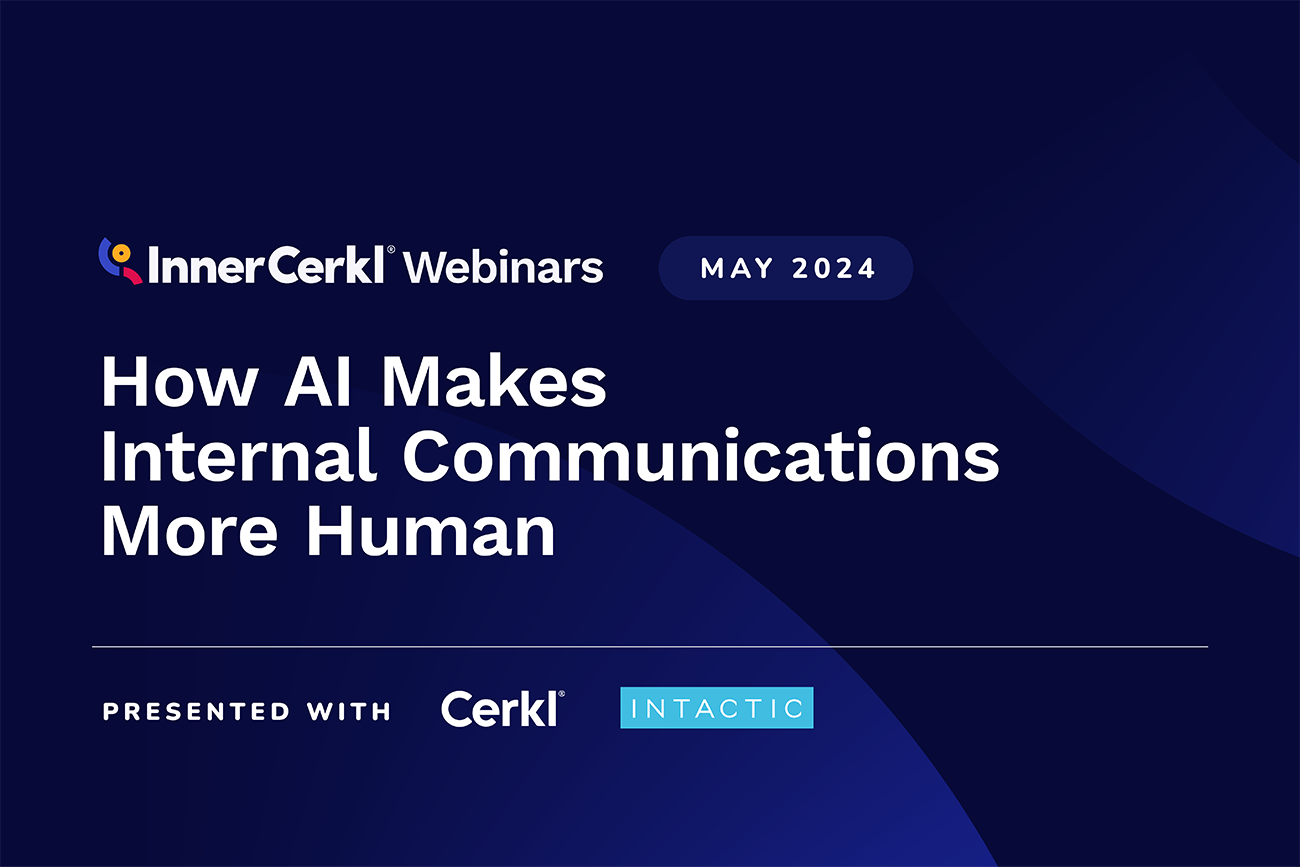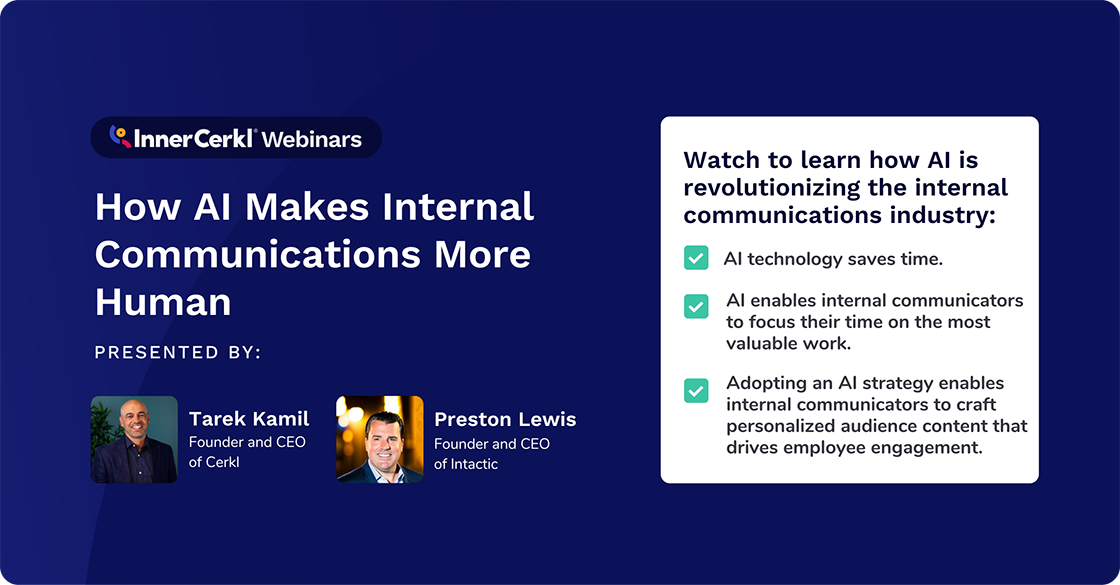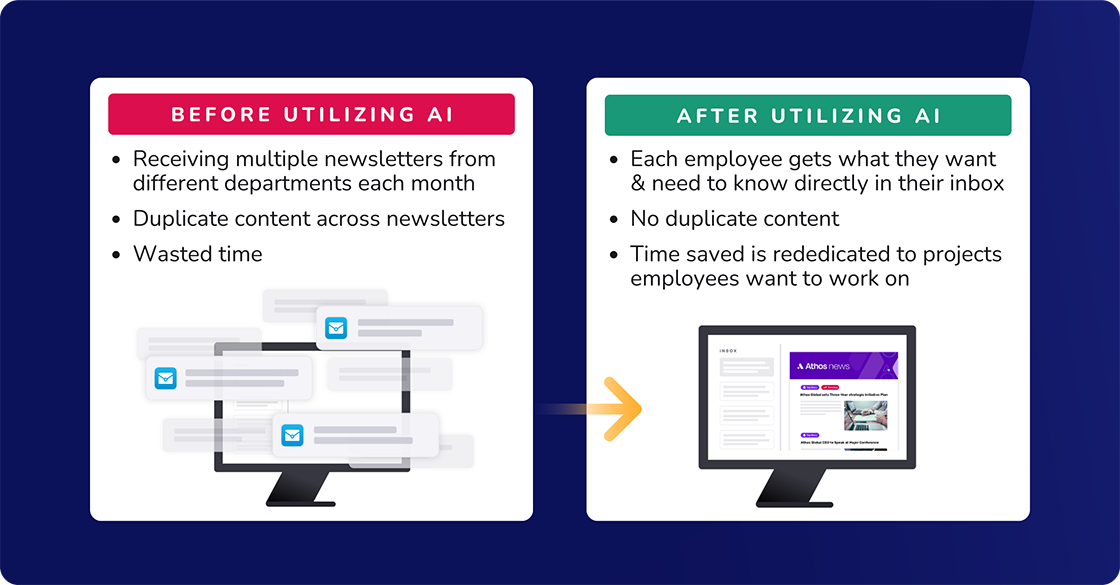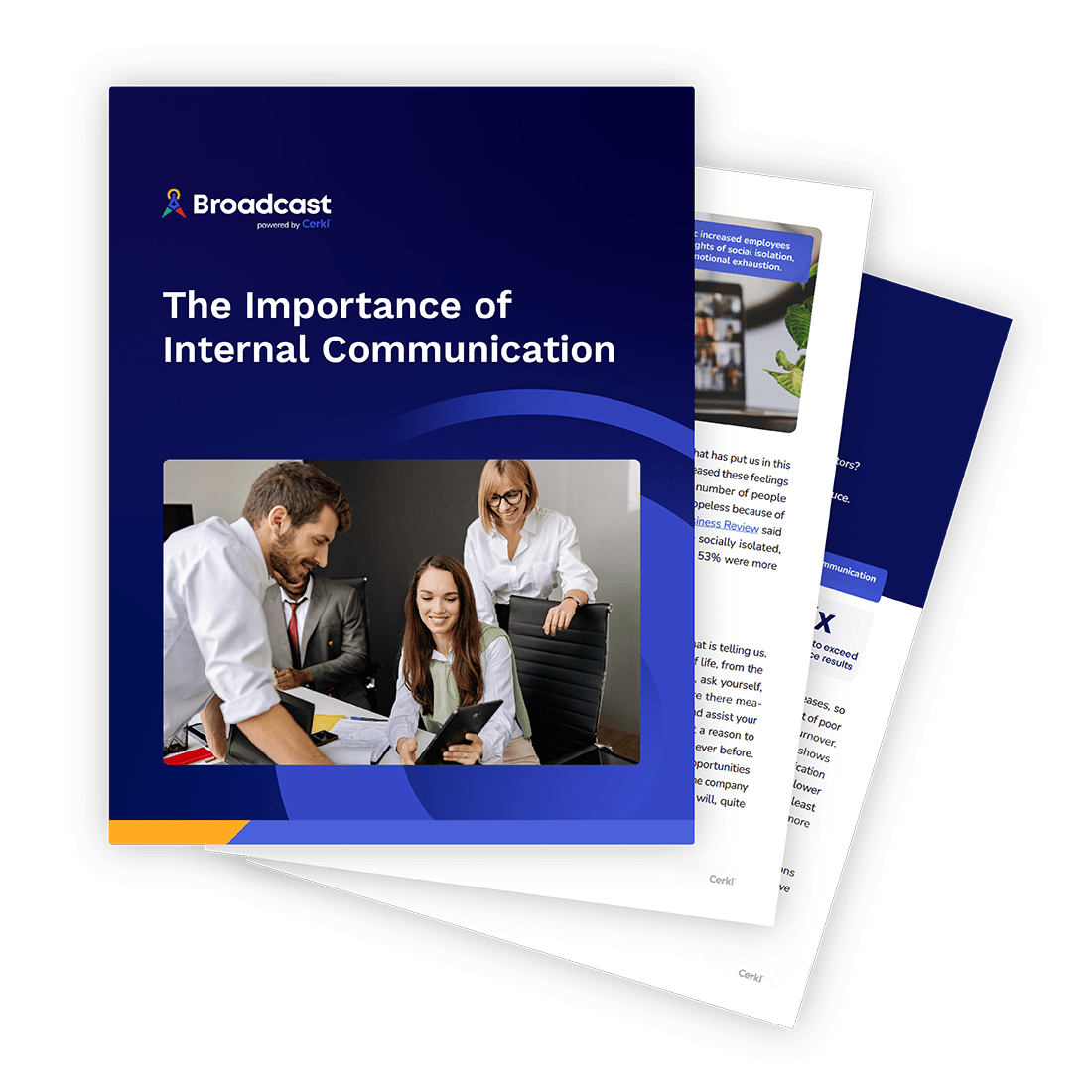"How AI Makes Internal Communications More Human" with Tarek Kamil, Founder and CEO of Cerkl, and Preston Lewis, Founder and CEO of Intactic.

.webp)
Effective internal communication is the backbone of every successful organization. Learn the ins and outs of internal communications with our research-backed white paper.
Access NowThe rise of artificial intelligence (AI) has sparked both excitement and intimidation in the world of internal communications. But what if AI could actually help make internal comms more personal, more engaging, more human, and more efficient?
There’s proof that it can and it does!
A recent webinar, How AI Makes Internal Communications More Human with Tarek Kamil, Founder and CEO of Cerkl, and Preston Lewis, Founder and CEO of Intactic, revealed the remarkable ways AI is revolutionizing the industry.
Some Highlights:
“AI is going to be the next COVID-type accelerant for internal comms because you can get out of the day-to-day mundane tasks, and you can be elevated to be more strategic. You can tie your work with ROI to company objectives.”
Tarek Kamil
When you weigh the evidence, why would you even consider ignoring it? One reason they highlighted is that there is often a lack of trust. This contrasts with the earned trust at the other end of the spectrum.
“We need to show how AI and other emerging tech impacts people's work every single day. The more proactive we are with illustrating the value of AI, the more we can improve levels of trust.”
Preston Lewis

A software engineer by training, Tarek identifies AI as a super-hot topic that’s been around for a while. Most people experience it every day via organizations like Amazon, Netflix, and Spotify that use AI to identify our preferences.
He highlights what AI is — “The simulation of human decision-making by computers” — and what it isn’t.
It isn’t what proponents of the simulation hypothesis like Elon Musk define as: “A technology that will become self-aware — eventually leading to the end of mankind.” It’s also not the same as machine learning technology, “The process by which a computer is able to improve its own performance by continuously incorporating new data into an existing statistical model.”
“What computers are doing is learning, and then artificial intelligence is the actual decision-making process. So, how does it understand what to do? This has been the big breakthrough with ChatGPT, and Gemini, and Bard, and all the others that have just exploded over the past 18 months. It is a process of learning we have never seen before.”
Tarek Kamil
Turn your internal communications strategy around today

As an internal communications practitioner who helps teams evolve strategies and use emerging technologies, including AI, Preston compares AI to the discovery of the wheel. The wheel isn’t valuable on its own. The power came when humans discovered what to do with it, he says. It was innovative humans who discovered how to use the wheel that realized the true value.
“I am excited about how AI technology is going to influence our work to make it more meaningful. Everyone in this world is experiencing what it is like to live with this technology at our fingertips. We are all only just beginning to understand what it could mean.”
But, “Is this going to move faster than we can control?” After all, it’s not even close to being regulated. However, it’s impacting all of us every single day.
“We have an unusual opportunity to illustrate the value of our work. An opportunity that can’t be missed.”
Preston Lewis
It seems we use the word human more now than ever, says Preston. Our work needs to include what keeps us humans up at night. We have to consider how important it is to understand the human experience of any content. We talk about a philosophy of experience. But, ultimately, humans care about only TWO things:
Clearly, AI plays an important role in both of these issues.
“AI is not a fad. This is not a thing that's going to go away if you just ignore it. It is here. It is going to become more pervasive. And for the communicators who adopt AI tech early, embrace it instead of fighting it, you will be able to be more strategic than ever. That is my prediction.”
Preston Lewis
Turn your internal communications strategy around today

Tarek tells how Cerkl was getting ready to roll out Broadcast for a global technology company just after they had done an internal comms audit. They had picked a couple of random people and discovered that on average, employees were receiving 26 different newsletters from different departments every month. The worst part was that a lot of it was duplicate content. Imagine the time wasted during this process!
One of the big benefits this organization saw in Broadcast immediately was that AI could do the job for them. Each employee would get what he or she needed to know that they hadn’t already seen — eliminating the need for humans to do this. “And no jobs are lost. I know people are wondering, is this going to impact my job? We've never seen that.”
Rather, time is rededicated to different areas and employees get to work on things they actually care about.
The employee receives completely tailored, relevant communication. This reduces the volume coming into each inbox, “which is a huge complaint we see from every company and all their employees.” There is also less email communication. “So, this is a great example of how AI came in and delivered a better result — without leading to someone losing their job.”
In agreement, Preston says, “Time is money. That's real value. So, that time gives us space to focus on our strategy. It enables us to evolve our roles as communicators or communications teams. It enables us to manage through change. That is obvious and is directly connected to how our work is changing.”
“Using AI technology beyond platforms like Cerkl simplifies things so that we can all be saving time, be that much more strategic, and create great experiences and content. All things that enable people to feel more human at work. So I feel like this could be a part one.”
Preston Lewis

Actionable takeaways relate to privacy, ethical considerations, awareness and documentation, change management, and predictions.
Unconsciously what is happening, says Preston, is that there is a spectrum with earned trust at one end and a lack of trust at the other. When people are closer to making decisions about AI technology and see how invaluable it is at work, they have higher levels of trust. There’s no surprise because these people are able to see the value of AI technology faster and more specifically, and they can see the impact very clearly.
On the other end, there’s a lack of trust. These are people who are further away from making decisions about how AI is being used in our organizations and our workplaces.
“What this means is we as communicators and leaders need to be proactive with the AI narrative in our organization. Specifically, very proactive in our strategies and our editorial planning. We need to proactively illustrate the value of AI technology and how it impacts people's work every single day. The more quickly we can improve levels of trust, the more quickly we'll be able to evolve that adaptive mindset for everyone.”
Preston Lewis
The AI Creation Framework for internal communicators has three levels:
Cerkl AI is learning about each employee and their interests, and then it’s tailoring. So, how we think about the world is really two buckets. One is what an employee needs to know (information that isn’t optional), and what an employee wants to know. We learn that from their behavior, what are they reading, what are they engaging in, how long, what channels, just like Netflix does. So, what AI is doing is delivering a hyper-personalized experience, just like we were six years ago. Obviously it’s much more sophisticated, with more channels, more insights, and analytics. But, it’s really around one aspect of AI, which is personalization, which, like automation, has been there with Cerkl from the beginning.
Here’s where we’re heading. Imagine creating a piece of content once, and that one piece of content is taken by AI. And then, for someone who works in a factory in Mexico, it is automatically delivered to that person in Spanish, at a different reading level vs the CEO who is based in France. It’s going to deliver that message totally differently in French, with much more sophistication. But the message is essentially the same.
We've been doing personal development journey mapping for a long time. We've been mapping what the touch points are that have a greater level of influence on the experience or maybe some that are less. Today, we're crafting relevant content by audience and persona that consciously aligns with nudge theory. This involves crafting messaging and nudges and content to be really clear and then delivering them within touch points.
We're able to use technology platforms not just to facilitate the evolution of those touch points or deliver knowledge or content to the right people at the right time but also to learn from that and evolve over time. We're much more sophisticated in terms of creating messaging and content for the right people on the right platform and channel.
We also partner more strategically with other functions and stakeholders throughout the business. Again, to evolve our scope, to evolve our value, and really illustrate that using technology the right way enables us to be that much more strategic.
Because of the groundwork that was laid by GDPR and CCPA, which most organizations have already adopted, the controls are already in place. So, ethical AI and the ability for employees to say don't track me or only show me in an anonymous way is already a reality. But it is definitely something that you should be asking technology vendors.
But the caveat is that laws vary between regions, and not all technology vendors apply these controls when they're trying to sell software. Software needs to be customizable so it aligns with what people want and need and what the regulations say in different parts of the world.
Cerkl Broadcast is an AI-powered internal communications platform that helps organizations personalize and automate their internal communications. It uses AI to analyze employee data and behavior and then uses that information to deliver targeted, relevant, and timely content to each individual employee.
By using Cerkl Broadcast, organizations can create a more personalized and engaging internal communications experience for their employees.
There are many features that Broadcast offers, and the Cerkl team keeps developing new ones to add value for customers. For example, Tarek shared with the Webinar audience that Cerkl has launched a feature where “Broadcast will go in and build newsletters for every employee — 10,000 employees, 10,000 versions of what's going on within your organizations all tailored subject line, story, all of it.
“And communicators are not used to that. They're used to being in total control, right?”
The average newsletter will be sent out once a week, at the same time. There will be a subject line, and everybody will receive the same content. “The problem with that is it's not tailored, it's not relevant, people tune it out.”
Admitting it takes internal communicators to “get used to” this kind of change, Tarek says, “It is all about trust building. I have to trust the technology. And once they're using it, they see the engagement skyrocket. They can't ever imagine going back to doing it. It just takes some time to get there.”
Ready to try Cerkl Broadcast?

Turn your internal communications strategy around today

Turn your internal communications strategy around today